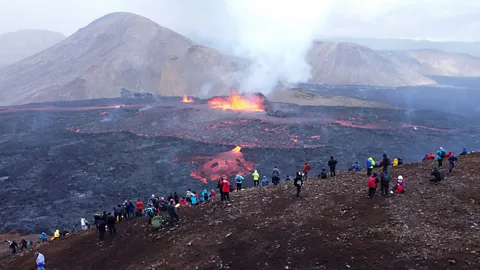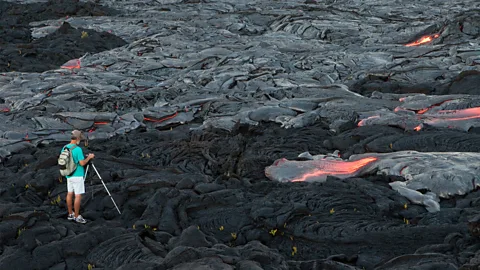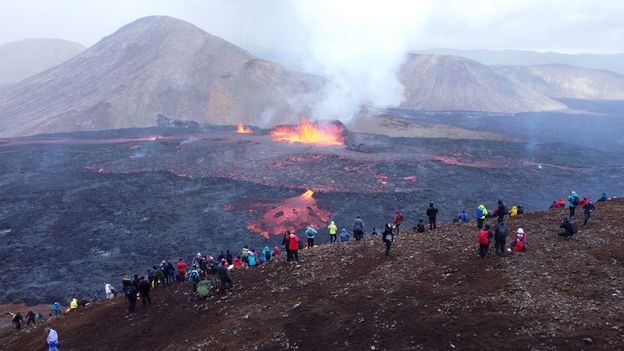 Getty Images
Getty Images
Volcanoes around the world attract millions of tourists each year (Photo: Getty Images)
When it comes to volcano tourism, travelers tend to split into two groups: those who want to stay away from volcanoes, and those who want to get close to volcanoes.
Volcano tourism has been on the rise since British businessman Thomas Cook first brought a group of tourists to Mount Vesuvius in 1841. Today, millions of people flock to places like Iceland, Italy, and Hawaii to experience the explosive power of local volcanoes. There are also more ways for travelers to experience these natural formations, from a simple hike in Hawaii’s Volcanoes National Park to rappelling up an active volcano on the island of Ambrym in Vanuatu.
In Iceland, the Blue Lagoon hot springs, one of the country’s most popular tourist destinations, was recently ordered evacuated due to the fifth volcanic eruption since December 2023. Located just 5 kilometers from Grindavík, a small fishing village where the eruption occurred, the hot springs are heated by geothermal power as they are located on a lava field. No fatalities have been reported as a result of this eruption, but several tourist deaths at other volcanoes have led to increasing questions about the safety of volcano tourism in general.
In 2019, during a sightseeing tour to Whakaari (White Island), a stratovolcano off the coast of New Zealand, 22 people were killed and 25 injured when superheated steam erupted from the volcano. The tragedy is featured in the 2022 Netflix documentary Volcano: Rescue from Whakaari. In 2023, Mount Marapi, one of the most active and popular volcanoes on the Indonesian island of Sumatra, unexpectedly spewed superheated ash, killing 23 hikers and injuring dozens.
So is volcano tourism safe? Luckily for adventure travelers, experts say it is, with a few very important precautions.
 Getty Images
Getty Images
Volcanologists say volcano tourism is safe with proper planning and respect (Photo credit: Getty Images)
First, it’s important to do a little research beforehand. “People who are going to a volcano for volcano tourism really need to educate themselves,” says Matthew Patrick, a geologist at the Hawaiian Volcano Observatory. “Find out what restrictions are in place, what local authorities are doing to keep people away and keep them safe.” This can include checking local tourism websites for the latest safety information and signing up for text alerts when visiting national parks.
Secondly, if you are going to travel to an active volcano, it is best to go with a reputable guide. Some sites, like Acatenango Volcano in Guatemala, allow tourists to visit on their own, but from a safety standpoint, it is best to join a guided tour of an active volcano.
“Every volcano is different, so people need to be aware of that,” Patrick said. “Some of the volcanoes in Hawaii have been essentially safe enough in the last few years to walk right up to the lava flows, but obviously you don’t want to get that close to an explosive volcano.”
Cultural sensitivity may also be required in places like Volcanoes National Park. In Native Hawaiian culture, volcanoes are considered living beings and eruptions are times of deep cultural and spiritual significance. Scientists and visitors alike are asked to be as respectful as possible of the deep meaning that volcanoes have to this community. Measures for a respectful visit include not disturbing the lava flow, not removing plants or rocks from the area, and not taking photos or videos of Native Hawaiians who may be praying near the area.
It’s not that hard to predict an eruption within a few hours, but they still sometimes surprise us – Kristin Vogfjord
Most tourist boards offer guidance on the best way to visit local volcanoes responsibly. Following the recent Icelandic eruption, the country’s tourism website has a dedicated page to provide up-to-date information. Evacuation measures are currently in place on the Reykjanes Peninsula, where the eruption occurred, but other parts of the country have resumed normal operations.
 Getty Images
Getty Images
Volcanologists say volcano tourism is safe with proper planning and respect (Photo credit: Getty Images)
According to Kristinn Vogfjord, geoscience research lead at the Icelandic Meteorological Office, advances in forecasting eruptions and dangerous phenomena such as toxic gas emissions associated with volcanoes have made volcano tourism much safer in Iceland and around the world. “Since 2000, we’ve been able to predict eruptions in Iceland,” Vogfjord says. “It’s not that hard to predict an eruption within a few hours, but they still sometimes surprise us.”
Not only can volcanologists now predict potential volcanic activity in advance, but thanks to significant collaboration between scientists and local officials, many places, including Iceland and the United States, have systems in place to communicate this information directly to both locals and tourists in near real time.
“We have an automatic notification hooked up to one of our monitors that watches for earthquakes,” Vogfjord explains. “When the alarm goes off, [the authorities] Something will happen when they arrive. [certain] “If the volcano level rises above 1,000 metres, an automated message is sent to all mobile phones in the area.” In the event of an emergency, Vogfjord said, these automated messages are sent in multiple languages to all mobile phones within range of the volcano, including those of tourists.
Tourists hoping to get a closer look at Iceland’s current eruption may be in for a long wait, as scientists believe volcanic activity in the region could continue for decades or even centuries to come.


